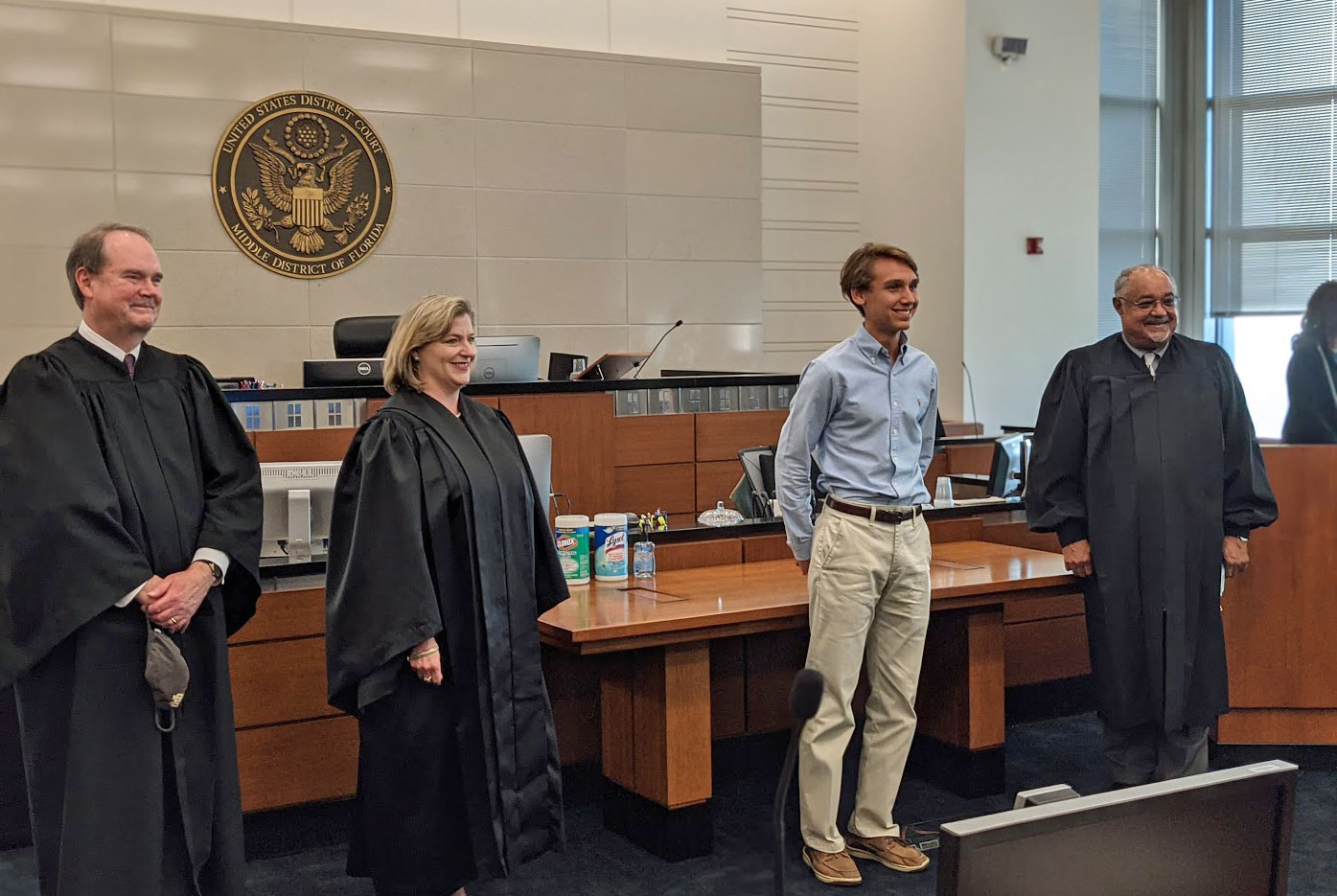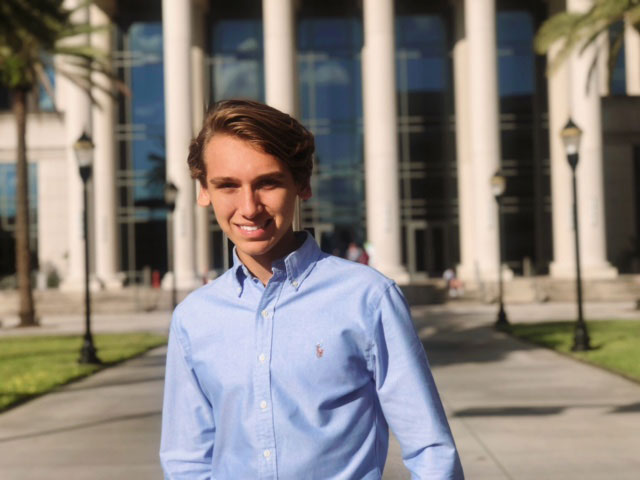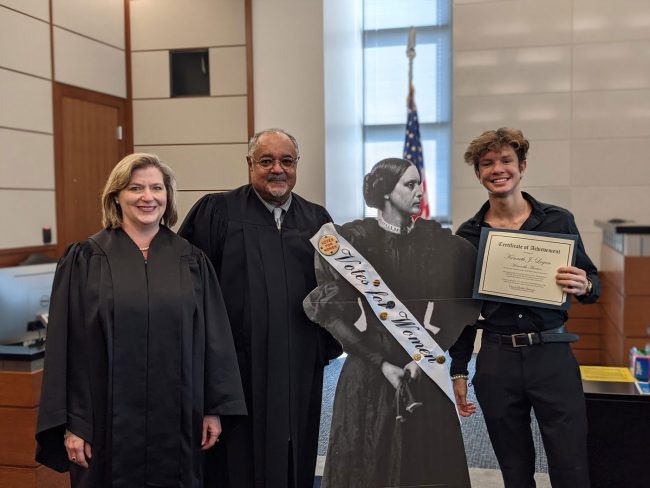
Sean Gilliam, a junior and International Baccalaureate candidate at Flagler Palm Coast High School, was the second-place winner Friday in the 2020 high school essay contest sponsored by the federal court for the Middle District in Jacksonville. He took home a $1,000 check, and a $500 grant for his teacher, Allison Elledge, who teaches history at FPC.
FPC junior Kenny Logan won honorable mention and $50. Contestants were asked to analyze the methods suffragettes used to win passage of the 19th Amendment, giving women the right to vote in 1920. The contest commemorated the centenary of the amendment and unwittingly coincided with an election year and a president whose odious response to his defeat continues to seethe with the rhetoric of disenfranchisement.
Gilliam and Logan–the only juniors among the 10 students placing in the contest–wrote of women’s nearly 75-year struggle from Seneca Falls to World War I to break down a patriarchal society’s entrenched and often violent bigotries against any measure of equality. “Men, otherwise decent citizens, reacted in the ugly spirit of a Saturday night drunkard beating his wife,” the historian Barbara Tuchman wrote, describing a phenomenon common to both sides of the Atlantic. “The strange physical fury generated by the women’s struggle for the vote was the most unsettling phenomenon of the Liberal era.”
The contest, organized by the lawyers and judges of the district and the members of the Jacksonville Chapter of the Federal Bar Association, drew some 72 essays from 10th, 11th and 12th graders in the 12 counties covered by the Middle District. Making it to the top was little short of a trial: all the essays were judged by lawyers, and the 10 shortlisted for awards were evaluated by the federal judges to get down to the top three.
The top $2,000 prize went to Michelle Acosta of Paxon School for Advanced Studies, an International Baccalaureate school in Jacksonville. Winners were honored in a ceremony at the federal courthouse hosted by District Judges Marcia Morales Howard, Timothy Corrigan and Brian Davis, and by Peggy Miller of the Federal Bar Association.
Elledge, who was with the FPC students in Jacksonville Friday, had made them aware of the contest in late summer. “Given that 2020 is both an election year and the 100th anniversary of women’s suffrage, it’s been especially exciting this year to focus on the historical struggle of suffrage,” Elledge said today. “Gaining the right to vote is so important historically because we proclaim that everyone is equal, therefore we must live up to that creed. Even with the passage of the 15th and 19th Amendments, disenfranchisement remains a problem today, as we saw in this election with the closing of polling stations. Both Kenny and Sean discussed in their essays the struggle that women went through– arrests, protests, and denials– and they understand why expanding democracy helps us forge a more perfect union. I could not be more proud of these students.”
Gilliam’s and Logan’s essays are reproduced in full below.
![]()
Sean Gilliam: Picketing Their Way to the Nineteenth Amendment
How long must women wait for liberty? Suffragists demanded an answer to this question for several decades before their efforts were recognized and ratified in the form of the 19th amendment to the U.S. Constitution. Early activists used a variety of tactics to improve the rights of women, especially regarding the right to vote. Eventually, major women’s rights organizations emerged, and devised strategies to ensure suffrage for all Americans, regardless of their sex. Although lobbying efforts and parade demonstrations raised public awareness of the issue of women’s suffrage, the picketing method served as the most effective to pass the 19th amendment in the United States.
The path to women’s suffrage commenced several decades prior to the passing of the 19th amendment, with the earliest public efforts of women’s suffrage conducted during the 1848 Seneca Falls Convention. Elizabeth Cady Stanton and Lucretia Mott were instrumental in convening over 300 men and women to discuss the existing gender inequalities throughout this period. Women’s suffrage was discussed during the convention and eventually sparked a passionate, nationwide civil rights movement.
Susan B. Anthony and Sojourner Truth were two of the most prominent pioneers in the suffrage movement and made headlines when they were turned away, arrested, and convicted in the U.S. vs Anthony case for attempting to vote in the 1872 election. Moreover, the outright denial of women’s civil rights was demonstrated in the Minor vs Happersett case, where Virginia Minor sued a registrar of voters for refusing to add her to a list of voters. Ultimately, Minor lost the case, which shed light on the fact that voting rights were not granted to all Americans, but elicited more cause for reform. This sparked a passion for millions of other women throughout the country, who showed their support by joining the National American Woman Suffrage Association (NAWSA).
Led by Susan B. Anthony and Carrie Chapman Catt, the NAWSA recruited wealthy members of this movement to build the movement and start professional lobbying campaigns in individual states to rouse support for women’s suffrage. Between 1910 and 1918, state-targeted lobbying won the votes of seventeen states to support women’s suffrage after long, hard-fought campaigns. This revitalized the spirit of many women in hopes that this attitude would spread nationwide and suffrage expand to women all over the country.
Parading efforts had a similar effect, but were significantly more large-scale than previous methods of activism. The most renowned parade during this time period, organized by Alice Paul, occurred on March 1, 1913, immediately preceding President Wilson’s inauguration. The entire city was entranced by the growing number of supporters for women’s suffrage, and blatantly ignored the president’s arrival at Union Station. Pageants emerged as a result of these parades, which was yet another method for raising money and awareness to the issue of women’s suffrage and gender inequality. It soon became a critical component of parades, and linked artistic inclinations with political activism, which drew many suffragists to perform in them.
While lobbying rallied support in individual states in favor of women’s suffrage, picketing efforts in various major locations, including the White House, caught the attention of President Wilson and led to a domino effect that improved women’s rights tremendously. The National Women’s Party (NWP) had organized pickets in front of the White House since January 10, 1917, six days a week, as a drastic measure to appeal to President Wilson and legislators in Congress. These women, known as the “Silent Sentinels,” lined the streets and held signs that criticized the undemocratic nature of the U.S. for as long as women were denied suffrage.
Shortly thereafter, the U.S. became involved in World War I in Europe, and many suffragists thought to put activism on hold until the war ceased. However, the leaders of the National Women’s Party saw these circumstances as the perfect opportunity to become more confrontational and continue the demonstrations. At first, this strategy backfired, since much of the public accused the NWP of being unpatriotic during the war. Despite the backlash, the Silent Sentinels returned to the streets of Washington, D.C.. When they resisted police attempts to confiscate their banners, the women were arrested. Over the next several months, women faced violence, arrest, and verbal retaliation. As they served their sentences in jail, women went on hunger strikes and demanded to be treated like political prisoners, which continued the protests even in jail.
While in jail, Alice Paul, leader of the National Women’s Party, famously declared, “When men are denied justice, they go to war. This is our war, only we are fighting it with banners instead of guns.” This exemplified the peaceful nature of the protests in comparison to the ongoing war in Europe, which rallied much support among the public, even President Wilson. Wilson changed his stance on women’s suffrage in 1918, but it took another full year for the ratification process to begin. The Susan B. Anthony amendment–the 19th Amendment–came into effect on August 26th, 1920, after 72 years of struggle.
Numerous tactics were used by many proponents of women’s rights to establish suffrage for all Americans. Lobbying, parading, and lawsuits all brought change and awareness to women’s suffrage, but it was picketing that led to arrests that convinced President Wilson to change his stance, which proved to be the most beneficial method used by the suffragists. While the suffragists had a difficult journey to achieve the ultimate goal of suffrage, their battle triggered movements in waves that would improve women’s lives for generations to come.
Sean Gilliam has lived in Palm Coast for 17 years and is a junior attending Flagler Palm Coast High School. Along with his involvement in the International Baccalaureate program, Gilliam is a varsity runner on the FPC Cross Country and Track teams and participates in several extracurricular activities throughout his school. He is very active in his community through the Student Government Association, Future Problem Solvers, and a member of the National Honor Society.

![]()
Kenneth Logan: Their Own Great War
Airplanes, the Model-T, the Titanic sinking, and World War I all have something in common. They happened before women got the right to vote. It took the United States of America 144 years to finally give half its population voting rights. And it’s not as if Americans woke up one day with the startling epiphany that men and women were created equal. Instead, a battle was fought on the hills of economics, in the fields of public opinion, and through the jungles of political enmity.
The Nineteenth Amendment was first introduced in the Senate in 1878 and rejected. Every year thereafter it was proposed and rejected. Finally, in 1918, the amendment passed in the House of Representatives, needing only Senate approval. Again, it was rejected. Even after it passed through Congress, it was only ratified by one last-minute vote change. The fight for suffrage was not an easy triumph, nor were its soldiers listless and apathetic. Women suffered to earn suffrage, engaging in hunger strikes or becoming victims of beatings and arrests.
At the time, many Americans were shocked at the idea of women voting. Newspaper editorials argued that women could not be mothers and voters, and how could women possibly know anything about politics and government? The first organized movement for women’s suffrage took place in 1848. Between then and 1920, numerous efforts were made to achieve a victory for women’s rights. Although many of these efforts were significant, World War I caused the largest impact because it revealed to Americans that women could work beyond the home, be civic-minded and patriotic. It was apparent that women cared about their country in the same manner that men did. However, the women’s suffrage movement started long before the Great War.
The history of the women’s suffrage movement is, unfortunately, long. During the Progressive era, women demanded that changes be made to the political system, arguing foremost that women get the right to vote. Elizabeth Cady Stanton, who was a driving force in the women’s rights movement, initiated this conversation. It inspired her to organize an assembly for women’s suffrage, which resulted in the Seneca Falls Convention. Three-hundred people showed up to discuss “the social, civil, and religious condition and rights of women.” Here, Stanton revealed the Declaration of Sentiments, based on the Declaration of Independence but with a plot-twist: men and women were created equal. Stanton’s method of changing the public’s mind about women’s rights was to echo the founding fathers’ in creating a document illustrating how women lacked rights. One hundred people in attendance signed the Declaration of Sentiments. Despite this having worked when America separated from England, Stanton’s version didn’t effectively sway public opinion. The idea of women voting was radical and received harsh criticism. However, it clearly ignited the spark for the women’s suffrage movement since only two weeks later, the next convention was held in Rochester, New York.
Throughout the women’s suffrage movement, many other methods were used to sway public opinion. Women lobbied and picketed. They protested and became ardent political figures. They even held hunger strikes in prisons and voted illegally, then sued the government for violating the Fourteenth Amendment. None of these tactics, however, had the impact of World War I.
World War I was the turning point for women’s suffrage. It allowed women to show not only that they could do more than just be housewives, but it also provided the perfect argument for giving women the right to vote. When most working-aged men went to war, women took their places in factories and farms, they made ammunition and many directly helped the cause by either enlisting or volunteering for the American Red Cross. Women were doing things that society had never expected them to be able to do, and filling roles many thought they couldn’t fill. They were vital contributors overseas as nurses and ambulance drivers. In taking these responsibilities, American society saw that women might not be such fragile dependents. Women also started joining the Navy. Although the number of women who joined was limited and they were restricted to clerical work, seeing women in uniforms revealed that they were capable of holding positions with a measure of strength and power.
President Woodrow Wilson claimed that America was going to war to protect democracy. He felt sympathy for the people of Germany because they were not self-governed. The suffragettes quickly brought up the point that half of America was not self-governed either. Carrie Chapman Catt, a suffragette, argued that if they were fighting “for democracy and against autocracy, the United States could hardly continue to disenfranchise half its population by denying them the right to vote.” These women had a different method of fighting for suffrage.
Instead of criticizing American policies, they made the point that society wasn’t living up to what it truly meant to be American nor to what is written in the founding documents. This is supposed to be a country where everyone is free, where everyone gets a say in what happens in their day-to-day lives. Women shouldered as much responsibility as the men did in the war. If they could die for their country, why shouldn’t they be able to vote? This massage swayed the American public and forced Wilson into fully supporting women’s suffrage. In 1918 he publicly endorsed allowing women to vote, and two years later the Nineteenth Amendment was ratified.
Women weren’t just given the right to vote. They had to fight for it. They tried many different methods. Some were unavailing, while others ultimately convinced the American people. Of these approaches, the suffrage movement during World War I was the most successful because it forced America to see women for who they truly are: equal.
Kenny Logan has lived in Palm Coast for 12 years, and plans to study law or mechanical engineering.





























Nina deBodisco says
Amazing essays, these two young men make Flagler proud!